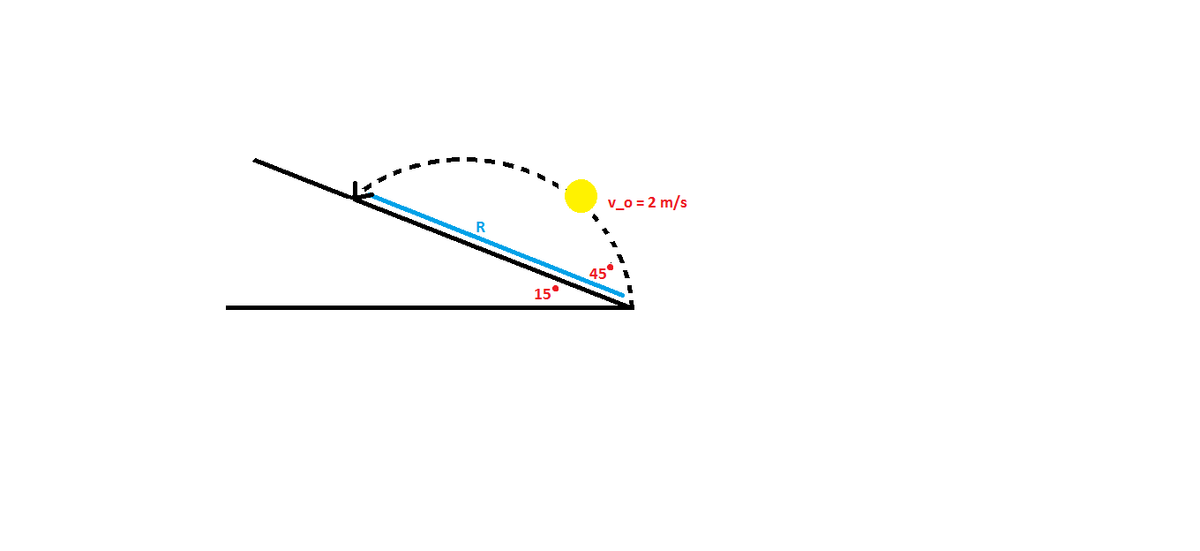Ball Thrown Up An Inclined Plane

A yellow ball is thrown with initial speed up an inclined plane. The plane is inclined at an angle above the horizontal, and the ball's thrown with an angle above the plane. If denotes the ball land's distance, find the value of . (assume )
I found that the answer is , but I'm not sure. Could anyone clarify? Thanks :)
No vote yet
10 votes
Easy Math Editor
This discussion board is a place to discuss our Daily Challenges and the math and science related to those challenges. Explanations are more than just a solution — they should explain the steps and thinking strategies that you used to obtain the solution. Comments should further the discussion of math and science.
When posting on Brilliant:
*italics*or_italics_**bold**or__bold__paragraph 1
paragraph 2
[example link](https://brilliant.org)> This is a quote# I indented these lines # 4 spaces, and now they show # up as a code block. print "hello world"\(...\)or\[...\]to ensure proper formatting.2 \times 32^{34}a_{i-1}\frac{2}{3}\sqrt{2}\sum_{i=1}^3\sin \theta\boxed{123}Comments
vx=2cos60∘=1
vy=2sin60∘=3
x=vxt=t
y=vyt−21gt2=3t−5t2
Because tan15∘=xy, then x=t=y(2+3)
By substituting t=y(2+3) to y=3t−5t2,
y=3(2+3)y−5(2+3)2y2
y(5(7+43)y−2(1+3))=0
Since y=0,
y=5(7+43)2(1+3)
Because sin15∘=Ry, then R=sin15∘y
Hence, R=542(2−3)
Log in to reply
Firstly, good question Nabila and great effort on your answer.
Fariz nice approach to the question, I completely agree with your answer as I verified it using a different method; which was finding the intercepts of the trajectory of the projectile and the plane.
I found using simple physics formulae that the height is 0.15m
I then used this to model a formula for the trajectory; y=ax2+bx where b is the initial gradient of the projectile tan(π/3),
Using height of 0.15, a was found to be −5
Hence, y=3x−5x2 is the trajectory in the Cartesian coordinate system
This is now intercepted with the plane which is linear; y=bx, were b is tan(π/12)
Therefore the plane is represented as; y=(2−3)x
Furthermore, the coordinates of the intercepts of the trajectory and the plane are calculated to be:
y=56(3−2) and x=52(3−1)
Finally, using Pythagoras's Theorem, R=(52(3−1))2+(56(3−2))2
Hence, R=542(2−3)
Log in to reply
Nice one!
Mathematical approach, cool :)
Thanks, it seems my answer yet completed
Nice solution, though just a slight mistake in the end. I believe, you can easily get the right answer if you try to deduce a point in the trajectory where xy=tan15∘ using the above equations. This would give the required R most probably.
Log in to reply
Would you like to fix it, Lokesh? I'm not sure about my answer.....
Log in to reply
Referring to your solution, equation (3) and equation (4) define the trajectory of ball. The ball lands at the point (x,y) such that xy=tan15∘.
Solving these three equations, the point can be located and hence the distance where the ball lands. Diving equation (4) with equation (3), xy=3−5t and using xy=tan15∘, finally 3−5t=tan15∘⇒3−5t=2−(3).
Solving this we have x=t=523−2. Using trigonometry we get Rx=cos15∘ and hence R=cos15∘x⇒R=5(6+2)4(23−2).
Finally, R=54(22−6) which is same as yours. Hahaha. I was wrong about your solution. Sorry about that one.
Log in to reply
Haha it's okay.
Range=5∗cos2152∗sin45
it should be 4 (sqrt2)/5
Log in to reply
Yes Victor is right. You may even use trigonometry sin 15 = (sqrt3-1)/2
Hey, I think what you found was incorrect in the sense that what you found wasn't what the question was asking for. I found that your answer was what I got for the horizontal distance, not the actually length between the ball land's distance. What I did was find the equation for both lines (the inclined plane and the trajectory) find the intersection which is where you got, and the last bit is apply the Pythagorean theorem to get that length.
54(26−32) ??
Log in to reply
How did you get the answer?
Log in to reply
yes.I agree
tan15=y/x =(2.sin60.t-1/2.10. t^2)/(2.cos60.t)
2-sqrt{3} =sqrt{3}-5t
t={2/5}(sqrt{3}-1)
R= x/sin 15 =t/sin 15 = {4/5}sqrt{2}
Log in to reply
R = x / cos 15
Log in to reply
Yes you are right Lokesh. R=x/cos15 that gives me the same answer as yours
rotate Oxy 15
gx= -10sin15; gy= -10cos15
t = 2vsin45/gy
R=vcos45t - 1/2 * gx * t^2 =2*(1 - tan15)/cos15
We need to start by finding final speed, vf.
After that, u can start using conservation of mechanical energy
Ki+Ui=Kf+Uf
21mv02=21mvf2+mgRsin45∘
v02=vf2+2gRsin45∘
Now u have all the values except R and u can easily find R
Log in to reply
What is the value of vf?
Log in to reply
U can use the equation of kinematics
In the y-direction
vyf2=(v0sin45∘)2−2gRsin45∘
vyf=v0sin45∘−gt
Rsin45∘=v0sin45∘t−21gt2
Rsin45∘=21(vyf+v0sin45∘)t
In the x-direction
Rcos45∘=v0cos45∘t
Using the equations, we can find vyf. We also have vxf=vxi=v0cos45∘. Then u can find vf by Pythagoras theorem: vf=vxf2+vyf2
i think it would be R=uusin2*/g=0.4m